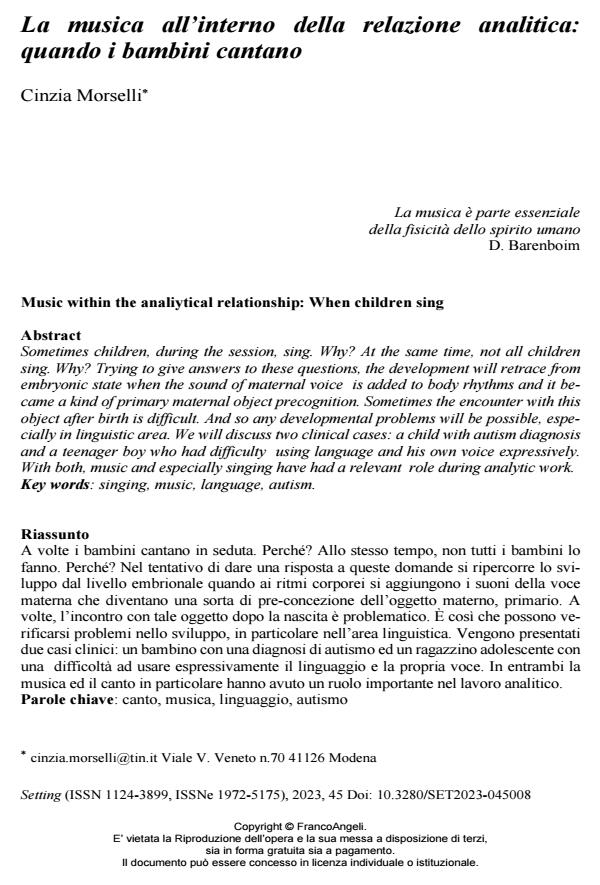Music within the analiytical relationship: When children sing
Journal title SETTING
Author/s Cinzia Morselli
Publishing Year 2023 Issue 2023/45 Language Italian
Pages 18 P. 97-114 File size 272 KB
DOI 10.3280/SET2023-045008
DOI is like a bar code for intellectual property: to have more infomation
click here
Below, you can see the article first page
If you want to buy this article in PDF format, you can do it, following the instructions to buy download credits

FrancoAngeli is member of Publishers International Linking Association, Inc (PILA), a not-for-profit association which run the CrossRef service enabling links to and from online scholarly content.
Sometimes children, during the session, sing. Why? At the same time, not all children sing. Why? Trying to give answers to these questions, the development will retrace from embryonic state when the sound of maternal voice is added to body rhythms and it became a kind of primary maternal object precognition. Sometimes the en-counter with this object after birth is difficult. And so any developmental problems will be possible, especially in linguistic area. We will discuss two clinical cases: a child with autism diagnosis and a teenager boy who had difficulty using language and his own voice expressively. With both, music and especially singing have had a relevant role during analytic work.
Keywords: singing, music, language, autism
- Anzieu D. (1985). L’Io-pelle, trad. it Borla, Roma, 1994.
- Beebe B., Lachmann F. M. (2002). Infant research e trattamento degli adulti. Ed. Raffaello Cortina (2003).
- Bernstein L. (1976). The unanswered question. Cambridge, MA: Harvard University Press.
- Bisagni F. (2009). The sound hand. Jpour. Of Child Psychth., 35(3), 229-249.
- Carta S. (2009). Music in dreams and the emergence of the self. Journ. Of Analytical Psychol., 54, 85-102.
- Chatwin B. (1987). Le vie dei canti. Ed Adelphi, Milano.
- De Benedetti A. (2000). Prima della parola. FrancoAngeli, Milano.
- Ehrenzweig A. (1953). The psychoanalysis of artistic vision and hearing. Shelton Press, London, 1975.
- Ferro A. (1992). Tecnica della psicoanalisi infantile. Ed. Raffaello Cortina, Milano.
- Vallino Macciò D. (2004). Essere neonati. Osservazioni psicoanalitiche. Ed Borla, Roma.
- Stern D. N. (1977). Le prime relazioni sociali. Trad. it. Armando Roma, 1982.
- Stern D. N. (1971). Le interazioni madre bambino nello sviluppo e nella clinica. Trad. it. Raffaello Cortina, Milano, 1998.
- Salk L. (1973). The role of the heartbeat in the relationship between mother and infant. Scientific American, 228, 24-9.
- Peretz I. (2001). La musica ed il cervello. In Enciclopedia della musica, Vol 2° Il sapere musicale. Ed Einaudi, Torino.
- Ogden T. H. (1989). Il limite primigenio dell’esperienza. Trad. it. Ed. Astrolabio, Roma (1992).
- Ogden T. H. (2009). Riscoprire la psicoanalisi. Ed. Cis, Milano.
- Nagel J. J. (2008). Psychoanalytic perspectives on music : an intersection on the oral and aural road. Psychoanl. Quarterly, 77, 507-529.
- Norman J. (2001). The psychoanalyst and the baby: a new look at work with infant. Int. Jour. Psycho-Anal, 82, 83-100.
- Maranhao Fagundes M. (2009). Un bebè sul lettino: un breve “sogno” sull’uso della funzione alfa. Quad. Psicot. Infant., 56(1).
- Mancia M. (1997). Riflessioni psicoanalitiche sul linguaggio musicale, Atti del Convegno “Le forme dell’immaginario. Psicoanalisi e musica”. Ed. Moretti e Vilati, Bergamo.
- Mancia M. (2001). La psicoanalisi ed il linguaggio musicale. In Sentieri della mente, a cura di Longhin l e Mancia M., Bollati Boringhieri, Torino.
- Mancia M. (2004). Sentire le parole. Ed Bollati Boringhieri, Torino.
- Maiello S. (2011). Dialoghi ante litteram. Note sugli elementi ritmici e sonori del linguaggio e della comunicazione verbale. Richard e Piggle 3, 246-266.
- Maiello S. (1993). L’oggetto sonoro. Richard e Piggle 1, 31-47.
- Leikert S. (2007). In Dantlgraber J. The Orpheus myth and psychoanalysis of music by S. Leikert Giessen, Int. Jour. Psycho-Anal., 88, 538-541.
- Lachmann F. M. (2001). Chapter 14. Words and music”, Progress in Self Psychology 17, 167-178.
- Haag G. (1992). Le identificazioni precoci nella formazione dell’Io corporeo, seminario per l’Associazione fiorentina di Psicoterapia Psicoanalitica.
- Gramajo N. N. (1993). Musical pleasure. Int. Jour. Psycho-Anal., 74, 383-391.
- Graf M. (1906). In Nagel J. J. (2008). Psychoanalytic perspectives on music : an intersection on the oral and aural road. Psychoanl. Quarterly, 77, 507-529.
- Ferro A. (2006). Tecnica e creatività. Il lavoro analitico. Ed. Raffaello Cortina, Milano.
- Ferro A. (2002). Fattori di malattia, fattori di guarigione. Ed Raffaello Cortina, Milano.
- Ferro A. (1999). La psicoanalisi come letteratura e terapia. Ed. Raffaello Cortina, Milano.
Cinzia Morselli, La musica all’interno della relazione analitica: quando i bambini cantano in "SETTING" 45/2023, pp 97-114, DOI: 10.3280/SET2023-045008